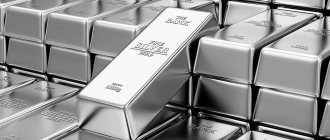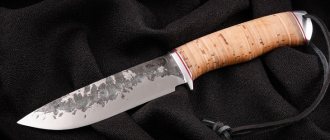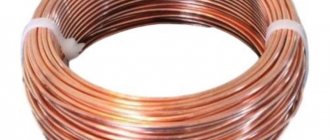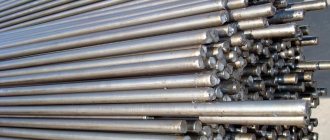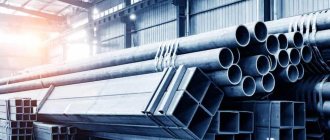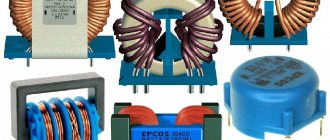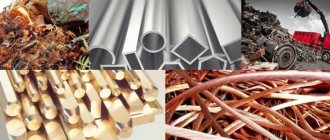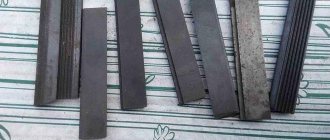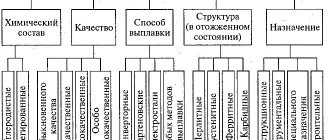Steel 09g2s: characteristics and application
The main areas of use of this brand: sheet and shaped products.
For hot-rolled strip, GOST 103-2006 standards are used, but steel circles are in accordance with GOST 2590-2006. As already noted, steel 09g2s and analogues are easy to weld. The characteristics already listed allow the use of this material for products that require high wear resistance: beams, channels, corners.
Brand 09g2s, its technical characteristics, are necessary in the creation of vehicles, construction, oil and chemical industries. A wide temperature range allows the material to be used where severe deformations occur over a long service life. At the same time, the limiting temperature of -70 degrees facilitates the use of products made from St. 09g2s in harsh climatic conditions.
Steel 09g2s is used in the construction of RVS for storing petroleum products in the North
Steel 09g2s-15 also fits this description well. It is used for all of the above points. It only remains to add that in addition to welding, installation can be carried out using bolted connecting elements. The metal's resistance to chemical influences makes it interesting in the relevant industry. At the same time, high mechanical qualities are used for the construction of bridges, roads, port stations, etc.
The 09g2s-12 brand is also popular among builders. It also has stable plastic properties. It is distinguished by a special chemical composition, which includes arsenic. Used for the manufacture of pipeline fittings. Cannot be used in the food industry.
In the north of Russia, many kilometers of pipelines were built using just this brand. There, more than anywhere else, frost resistance and easy weldability of products are useful. This allows you to create complex, at the same time socially significant objects (metal structures) from 09g2s and analogues.
At the same time, for cities with a temperate or continental climate, steel 09g2s according to GOST standards of various numbers is suitable for beautifying streets. Square pipe is extremely popular as fencing, posts for billboards, installation of mobile trading platforms, and much more. For the same purposes, the rectangular configuration of products is used.
Steel 09g2s, the characteristics of which have already been discussed in some detail in this presentation, is of interest to welders, regardless of the method of performing work. Flanges made of this material are especially popular. Features of the work are described in GOST 19281-73. The craftsmen are quite welcoming to the news about the need to work with this brand.
The boiler tank itself is made of steel 09g2s
Steel 09g2s with different strength classes can be used for the production of steam boilers, as well as equipment used in the agricultural complex. Details about the requirements for steel 09g2s in GOST-5520 79.
An additional reason for using alloys of this brand is high efficiency, achieved not only due to low cost of production. The ease and speed of construction of buildings, structures, installation of equipment also allows you to optimize the costs of enterprises in various industries.
Designations of steel and alloy grades
Steel 9xs and hvg: characteristics, heat treatment and application
In the brand designation, the first two digits indicate the average carbon content
in hundredths of a percent. The letters behind the numbers indicate: C-silicon, G-manganese, N-nickel, M-molybdenum,
P-phosphorus, X-chromium, K-cobalt, T-titanium, S-aluminium, D-copper, B-tungsten, F-vanadium, P-boron, A-nitrogen,
N-niobium, C-zirconium.
The numbers after the letters indicate the approximate content of the alloying element in whole units.
The absence of a number means that the content of this element is up to 1.5% (upper limit)
In carbon structural steels at the end (kp, ps, sp, respectively - boiling, semi-quiet, calm) depends on the degree of deoxidation. For example, Steel 3kp, etc. boiling. not suitable for welding because will boil - oxidize. because it was not deeply deoxidized during the smelting process. Each brand has its own purpose.
Sharpening
08x18n10t: steel characteristics, interpretation, analogues
Primary sharpening is performed at the factory during manufacture. The new cutter has a ready-made cutting edge profile with respect to the angles. But during operation, the tool wears out and needs to be sharpened.
When do you need to sharpen a cutting tool?
Cutter wear affects the speed, quality and accuracy of processing. When manually feeding a parting or grooving cutter, it feels like the tool is moving slowly.
In automatic machining, signs of wear are:
- Change in chip color.
- Deterioration of surface quality.
- Sparks during turning.
- Whistle, vibration.
- The appearance of chips and nicks on the cutting edge.
Advice! It is not recommended to use the cutter until the cutting edge is completely dull.
General execution rules
Sharpening is performed on a sharpening machine. For carbide materials, a circle made of electrocorundum is provided. A high-speed steel tool is sharpened on a green carbide wheel.
The cutter is placed on the tool rest and pressed against the rotating circle. To obtain a flat surface, it must be moved along the circle. The cutting edge should be located in the center of the circle, at least 10 mm higher. When all surfaces are ready, a small rounding is made at the intersection of the main and secondary cutting edges.
Important! The gap between the tool rest and the abrasive wheel is allowed no more than 3 mm.
To prevent overheating of the cutting edge, it is necessary to periodically cool it. For this purpose, there should be a container of water near the sharpening machine. If cooling is neglected, microcracks will form on the surface of the edge. They are not visible to the naked eye, but the durability of the tool and the quality of processing are reduced.
To increase the durability of the cutter and straighten the edges, finishing is performed. Depending on the material of the tool, diamond (for carbide) and CBN (for high-speed) finishing wheels are provided for this purpose. To control the cutter angles, special templates are used.
Nomenclature
The material is a product of powder metallurgy, which is due to a specific production method. The blanks are mainly sheets and plates of the brazed or multifaceted type. In the first case, maximum distribution is ensured in the manufacture of standard cutters, in the second - cutters for CNC machines. The first type of tool is subjected to manual sharpening, and the second – automated, using special equipment.
Return to content
Analogs
Steel x12MF characteristics, application
Of course, steel smelting and its subsequent processing is, one might say, a widespread phenomenon, which means that the means for that very processing should be widespread and in large quantities. And it is not surprising that among such a variety there are several alloys reminiscent of our T15K6. The decoding of the abbreviations will most likely differ, since the designation system of each country may vary, but in general the composition of the alloys is close or identical to the Russian analogue.
So the list looks something like this:
- Sweden – MS111;
- Poland – S10 and S10S;
- Germany – HS123, HT01 and HT02;
- Czech Republic – S1, T2.
Knowing these names, you can easily find a cutter made from the alloy you need.
Grades of hard alloys: classification of materials
Hard alloys are classified according to two main criteria.
Method of obtaining
According to the method of production, hard alloys are divided into two types.
- Cast. They are made using casting technology. Alloys of this group include stellites, sormites, and hard alloys with a high nickel content. Typically, pressing and thermal post-processing (hardening, aging, annealing, etc.) are used in production. The result is high quality materials. Cast carbide alloys are intended for surfacing on metalworking tools.
- Sintered. Such hard alloys are also called metal-ceramic due to the fact that the manufacturing technologies are very similar. The materials are produced using powder metallurgy technology. It is supplemented by laser/ultrasound processing or acid etching. The resulting materials are of the highest quality.
Sintered carbide alloys are fixed to tools mechanically or using soldering technology.
Chemical composition
Based on their chemical composition, hard alloys are divided into 4 groups.
- Single carbide (tungsten-cobalt). Marking - VK.
- Two-carbide (titanium-tungsten-cobalt). Marking - TK.
- Tricarbide (titanium-tantalum-tungsten-cobalt). Marking - TTK.
- Tungsten-free. Marking - TN.
Hard alloys
Hard alloys are materials with a non-uniform (heterogeneous) structure. They consist of high-hardness, refractory compounds bound together by metal. In this case, the base is usually carbides of titanium, tungsten, chromium, tantalum or their compounds. And the function of the binder is performed by iron, cobalt, nickel, or their alloys with different percentages. Such alloys can withstand severe loads, are resistant to wear and thermal effects (up to 1500 °C).
Classification
Hard alloys have different classifications.
- According to the manufacturing method. Here they are divided into two main types:
From the name it is clear that the casting method is used to produce cast hard alloys. These include:
– sormites (base – iron; additives: silicon, chromium, carbon, nickel),
– stellites (based on cobalt and chromium; additives: nickel and tungsten),
– stellite-like alloys (base – nickel; additives: chromium, carbon, iron; unlike stellites, they have low chemical resistance).
Powder metallurgy is used to produce sintered alloys. It allows you to set the material exactly those properties that are needed to solve certain problems. Sintered alloys have an alternative name “cermet”. It arose due to the identity of production technologies with ceramics.
This method allows us to achieve the highest precision of products. This saves manufacturers from subsequent labor-intensive finishing, limiting themselves to light processing (grinding, acid etching, ultrasound, etc.).
The most common alloys of this type are:
– tungsten – VK (VK8, VK10),
– titanium-tungsten – TK (T15K6, T14K8),
– titanium-tantalum-tungsten – TTK (TT7K12, TT8K6).
On our website you can buy tungsten-cobalt hard alloys VK6, VK8, VK15, VK20 and titanium-tungsten-cobalt alloys T15K6, T5K10, T14K8, T30K4
Alloy overlays are fixed to instruments in two ways:
- By area of application.
According to this parameter, alloys can be grouped into:
- Structural. They are used primarily in machines, providing parts with high wear resistance. They may also have special properties (significant Young’s Modulus, density, tensile strength).
- Heat-resistant and heat-resistant alloys.
- Instrumental. They are used for drilling operations, in processing models by stamping, cutting, pressure, etc.
- Tungsten-containing.
They are almost always based on tungsten carbide, but tantalum and titanium carbides are also used. The metal bond is nickel or cobalt, or a bond of molybdenum and nickel.
- Tungsten-free.
The production of tungsten-free alloys is carried out in two ways, each of which involves the replacement of tungsten carbide:
- Using carbide of another refractory metal (vanadium, hafnium, zirconium, chromium, tantalum, etc.).
- Use of alternative hard metals (boride, nitride, silicide).
Basic information
Hard alloys are common in various industries. They are used to make parts for machine tools, cars, ships, aircraft, fasteners, building plates and other products. They are often used in the production of tools. It is advisable for people involved in metallurgy and blacksmithing to know basic information about what carbide is.
History of discovery
The history of the discovery of hard alloys begins at the beginning of the 20th century. Before this period, metalworking tools were made from tool steel, which was infused with carbon. However, the processing process was low-productivity and uneconomical.
By the beginning of the 20th century, high-alloy tool steel was developed through the joint efforts of metallurgists. It began to be used when processing difficult-to-cut types of metals at high speeds. After a short period of time, it received the name “high-speed steel.” Instruments made from it were first demonstrated to the public in 1910.
The development of tool technology did not stop there. In the USSR, USA and Germany, starting from 1925, mixtures of hard metals began to be produced as commercial products. Such products were made from tungsten carbide and cobalt metal. In the CIS countries, this alloy was called “win.” However, the new material could effectively process cast iron workpieces, but not steel. In this regard, the development of new compounds continued and in 1935 a tungsten-titanium mixture appeared. It was suitable for processing steel, but crumbled when working with cast iron.
In subsequent years, synthetic diamonds began to be used to coat the working parts of tools. Another development was elbor - a compound of nitrogen and boron.
Production Features
The production of T15K6 alloy consists of performing the following processes in the established sequence:
- Reduction of cobalt, titanium and tungsten from oxides to obtain pure substance and carbide compounds.
- Using a charge of 1-2 microns in size, which is obtained by grinding in ball mills with division into fractions.
- Connecting components according to proportion.
- Cold pressing using an adhesive that creates and maintains the shape.
- T15K6 hard alloy is sintered at 1400 C; in the range of 800-850 C the glue dries. With the required heating, cobalt transitions into a liquid state and wetting of tungsten and titanium carbides occurs. When crystallized, it provides hardness to the material by creating a strong crystal lattice.
- Machining using diamond-coated tools.
- Additional application of a special coating (titanium nitrite, etc.) if necessary.
How to choose the right grade of carbide
When choosing an alloy grade, you need to pay attention to their separation. These can be titanium-tungsten and tungsten mixtures
Steel is processed first, cast iron second.
Physical and mechanical characteristics also need to be taken into account. The power of the equipment with which the processing will be carried out plays an important role.
Advantages and disadvantages
Solid metal compounds have both advantages and disadvantages. Strengths include:
- High mechanical and thermal shock strength.
- Uniformity of structure.
- The sharpening on the instrument lasts much longer.
- High temperature resistance.
Disadvantages include the high price of tools and equipment made from solid compounds.
Hard alloy products
In hardware stores and markets you can find various products made from mixtures of hard metals. These can be various tools, parts for machines, machine tools, power tools, construction plates and other products.
Properties
If you know the school chemistry curriculum, then most likely you will remember what carbide itself is. It is an alloy of metals (or non-metals) with carbon. In most cases, they have high hardness, which is generally not surprising due to the high carbon content, and resistance to elevated temperatures.
If we “decipher” T15K5 into its components, we get something like this:
- Tungsten carbide has phenomenal strength. More precisely, its strength is approximately 93 on the Rockwell scale or 9 on the Mohs scale. To make it easier, we can stipulate that tungsten carbide is second only to diamond in strength.
- Titanium carbide has the same strength characteristics, however, unlike tungsten carbide, it is slightly more resistant to high temperatures.
- Cobalt here plays the role of a binder, but also increases the overall heat resistance of the material.
How to obtain hard alloys
Metal compounds are a mixture of powders that are pressed and baked. It contains carbides and cobalt. The powders are mixed in baking dishes and pressed under a pressure of 200 kgf/cm2. After pressure treatment, the molds are heated to a temperature of 1500 degrees. Ready-made compounds are used in the production of difficult-to-process materials.
Properties of hard alloys
To understand which metal or mixture is the strongest in the world, you need to know their properties. The main characteristics will help you understand certain types of materials and use them wisely in production. Properties of hard alloys:
- High mechanical and thermal shock strength.
- Wear resistance.
- Red fastness. This indicator appears at temperatures from 900 to 1000 degrees.
Properties of hard alloys such as impact resistance, ductility, compressive or bending strength and hardness directly depend on the amount of cobalt contained in the compounds. The grain size of the tungsten carbide is also important.
Characteristics of hard alloys
To determine the hardest alloy, you need to understand the characteristics. These include the chemical composition of the metal compound, its mechanical and physical properties, and the process of obtaining finished alloys.
Mechanical and physical characteristics:
- Heat resistance.
- Density (14.9g/cm3–15.2g/cm3).
- Hardness (89.5HRA-91 HRA).
- Thermal conductivity - 51 W.
- Permissible strength - 2150 MPa.
These characteristics also include the resistance of the compounds to the effects of corrosive processes. The hardest alloy has inflated physical and mechanical characteristics.
Heat-resistant metal
Stamps
According to state GOSTs, special markings are established that mark all compounds of hard metals. It consists of capital letters and numbers:
- VK6M - tungsten-cobalt mixture. The number 6 indicates the amount of cobalt in the composition. The letter “B” indicates tungsten, respectively, the letter “K” indicates cobalt. The letter “M” indicates the area in which this alloy is used. Tools for metal processing are made from it.
- VK2 - in this case the mixture contains 2% cobalt and 98% tungsten.
- BK8 - this mixture of cobalt contains up to 8%.
- T14K8 - such compounds contain a third element - titanium. It contains 14% of it. Cobalt 8%. Everything else is tungsten.
- T5K10 - similar to the previous mixture, in which 5% titanium, 10% cobalt and 85% tungsten.
- TT7K12 - tantalum is added to the above elements. Its percentage is the same as that of titanium.
Alloy grades are indicated on finished parts and blanks.
Areas of use
There are many applications for hard alloys. These include:
- Production of tools for metal processing.
- Manufacturing of parts for industrial equipment.
- Equipment for working with metal workpieces.
Often hard alloys are used as a coating on softer ones. The scope of application extends to the construction of large transport vehicles.
Application of T15K6 alloy
Let's start, perhaps, with the simplest. The first thing you need to understand is that this material is designed primarily for machining alloys and metals. Most often, cutting dies for metal lathes are made from it, less often - reamers for fine-tuning the alignment of holes in the workpiece, countersinks for removing internal chamfers of the same holes, cutters for removing a certain amount of metal from the surface of the workpiece, as well as making recesses and forming complex holes forms. The last three tools are most often used for the final, more delicate processing of a metal product, while cutters often carry out rough processing of the part, that is, giving the main shape.
As you might guess, steel has at least outstanding strength indicators, as it is used for the manufacture of cutting tools for metal turning. And we are not talking about banal hardness, but also about resistance to loads, because during turning the cutter experiences a constant lateral load. And, of course, resistance to elevated temperatures is also extremely important, because during processing, friction occurs at the point of contact of the part with the cutting edge of the cutter.
Perhaps only high-speed tungsten steel can have such characteristics. However, the decoding of T15K6 makes it clear for sure that this is not high-speed steel, but a super-hard alloy consisting of several types of carbides with the addition of a certain binder. So, in its essence, it is more like a simple composite material made of carbon-containing components than steel, but in many sources T15K6 is called steel.
What exactly do T15K6 cutters consist of? The decoding of the conventional name of the alloy tells us that its chemical composition is as follows:
- 15% titanium carbide;
- 6% cobalt.
However, this is only 21% of the total mass. As for the dominant element, in this case it is tungsten carbide.
Metal blockages
Sometimes they take any hard alloy within the VK8 alloy grade. It is quite highly valued, but there is no single price on the market. An expert can tell you the exact price after examining the product.
In addition to the listed differences, there is added a factor associated with the type of metal connection of elements from VK8 with the base of the product.
Cutters with inserts made of VK8 alloy
The mounting methods are fundamentally different. The output is either pure tungsten/cobalt after mechanical fastening with screws or with soldering of brass and other connecting metals. Preference is always given to pure metals, however, given the metallurgical industry's shortage of tungsten and cobalt, the desire to reduce the production of ores containing these chemical elements is accepted by almost all types of alloys, but at different prices.
Foreign analogs of VK8 alloy
| Germany | Sweden | Bulgaria | Hungary | Poland | Czech |
| DIN,WNr | SS | BDS | MSZ | PN | CSN |
| HG30, HG40 | MC241 | BK8 | DR30, DR40 | H30 | G1.1, G2 |
Comparison with another steel grade
For example, for 09g2s and st3 the difference is determined primarily by the carbon content. For St3sp it is 10-20 times higher than what is found in the low-alloy alloy.
St3sp – refers to carbon alloys. This grade of steel is characterized by high brittleness and rapid destruction at low temperatures. If the brand being described has a lower limit of -70 degrees, then the object of comparison is only -20.
The quality of St3sp is ordinary, which indicates a likely high presence of sulfur and phosphorus. Then, like 09g2s is high quality. All other advantages are already in the previous description. It only remains to note that the cost of this brand is significantly higher than the price of St3sp.
Video about low alloy steels:
Features of electric welding
There are special requirements for working with this material, which are determined by the need to comply with the technological process. The need to maintain the strength of steel at seams has already been noted. However, under normal conditions it is hardly possible to achieve an absolutely positive result.
For example, the condition for preventing overheating is achieved by using low currents of 40-50 A / 1 mm electrode. Welding work is accompanied by subsequent hardening of materials at a temperature of 6500C. However, based on the critical points of the alloy, you can make your own calculations for carrying out these works. Moreover, the specified hardening T is applied sequentially to every 25 mm of the seam, for about an hour. Cooling is carried out in ordinary water or in air. Thanks to technology, they achieve quality that is not inferior in properties to even more expensive alloys.
The main areas of application of hard alloys of various grades
Hard alloys of various grades are used in the following areas.
- Manufacturing of tools for metalworking. Hard alloys are used in the production of cutters, drills, crowns, cutters, discs, countersinks and countersinks, broaches, reamers, taps, dies, etc. (Here you can add many links to the relevant sections of the catalog)
Photo No. 2: carbide cutters for metal.
- Production of individual parts of measuring instruments. Hard alloys are used to manufacture components for equipment that experiences high loads during operation. High-precision surfaces are also made of carbide.
- Production of simple and complex shapes and matrices. They are used for casting various parts and blanks.
- Obtaining key parts of small sizes. These include bearings, terminals, rollers, balls, cages, etc.
- Production of equipment designed to operate under heavy loads. Drilling rigs, ore mining equipment, etc. are made from hard alloys.
- Manufacturing of individual parts for equipment. A great example is grader blade knives.
Chemical composition
The main components of the metal are carbide compounds based on titanium and tungsten, as well as cobalt. Carbide compounds are a ceramic material that provides hardness and heat resistance.
T15K6 hard alloy is used for cutting steel, the main area of application is the production of turning tools. Experts do not recommend using it for the production of cutters used for roughing. This is due to the low cobalt content, which is responsible for strength.
The strength characteristics of the material make it possible to cut various types of steel, including high-alloy grades. However, use in conditions of vibration or dynamic impact is not allowed.
Technical characteristics: subtleties of using reference manuals
The properties of 09g2s steel are largely determined by the chemical composition of the alloy, its specific parameters, which today are quite accurately calculated by metallurgists.
Steel grade 09g2s has the following critical points:
- Ac1 = 732, when austenite transforms into pearlite during cooling processes;
- Ac3(Acm) = 870 (s – from French chauffage/heating) the end point of cementite dissolution;
- Ar3(Arcm) = 854 (refroidissement – cooling) the beginning of the release of Fe3C;
- Ar1 = 680 hypoeutectoid steel, corresponds to ferrite precipitation
The symbols are classic, numbers 1 and 3 indicate the numbers of points on the graph. The symbols cm usually mark hypereutectoid steels.
If we talk about other features of St 09g2s, the following characteristics are noted: easy weldability of the material. For this purpose, RDS, ADS under flux and gas protection are used. Only products that have undergone chemical-thermal treatment cannot be welded.
The mechanical properties of steel 09g2s are tabular values that were developed by a number of GOST standards and describe the material at room temperature, as well as for its other states.
Among the important mechanical properties of 09g2s steel are the following:
- Yield strength for permanent deformation, measured in MPa;
- Relative values of elongation at break and contraction;
- Impact strength (use under load is one of the main applications);
- Brinell hardness (HB).
Strength class of steel 09g2s: the table for the list of grades includes the one indicated, which, as already noted, corresponds to C345. This also includes a number of other brands. Thus, steels that are different in chemical composition and even in the method of producing steel can have the same strength class. This data can be found for 09g2s according to GOST 19281-2014; the characteristics of the alloys are presented in convenient tables that are easy to navigate. You can view (download) GOST 19281-2014 here.
But the opposite situation is also possible. For example, for 09g2s GOST 19281-89 and grade 16GS there is data on strength classes 265 and 296.
The same GOST describes the types of rolled metal:
- Varietal, round, shaped with various sections (including circle 09g2s).
- Wideband profiles with a certain thickness of products.
Large diameter circles steel 09g2s
Similar information is provided for other brands.
The density of steel 09g2s fluctuates, somewhere around the 7800 kg/m3 mark. But alloying elements can either increase the specific gravity or reduce it. Tungsten tends to be the first. The second is achieved by adding: cobalt, nickel, copper.
The hardness of steel 09g2s can be determined by Brinell, Rockwell, Vickers, etc. the choice of system is determined by the type of products for which parameter determination is required. It is also important when choosing a welding method; the hardness of the steel at the weld should remain fairly high.
Most of the listed parameters can be found in TU 14 3 1128 2000 for steel 09g2s, as well as for other grades. The technical specifications describe the requirements for the materials from which pipes are made for servicing gas fields and other areas of the industry.
The permissible stress for steel 09g2s is calculated depending on the following values:
- strength class and grade;
- temperatures at which it will be operated;
- thickness, sometimes configurations (circle, sheet, etc.).
Existing 09g2s analogues are foreign (European, Asian, others), most similar in mechanical and technical properties to the specified brand. However, the chemical composition can vary greatly. The Bulgarian version of this brand has the closest configuration.
Classification and types of incisors
According to design parameters:
- Whole (one-piece). The cutter head is made as a single unit with the rod (holder). As a rule, such cutters are made of carbon tool steel or high-speed steels (for small cutters).
- With welded or soldered plates. The cutter head includes a welded or soldered plate made of high-speed steel or hard alloy (T5K10, T15K6, VK8, etc.). They have a wide range of applications.
- With mechanical fastening of plates. The insert is fixed in the cutter head mechanically. This method is especially useful for plates made of mineral-ceramic based material.
By feeding direction:
- Rights. The main cutting edge of the cutter, facing the surface of the workpiece, is located on the left side.
Left. The main cutting edge of the cutter, facing the surface of the workpiece, is located on the right side.
According to the location of the main cutting edge relative to the cutter shaft:
- Direct. The projection axis of the cutter part in the top plan and side view has a straight line.
- Bent back. The projection axis of the cutter part in the top view has a curved line, and in the side view it has a straight line.
- Curved. The projection axis of the cutter part in the top view has a straight line, and in the side view it has a curved line.
According to the material from which the working part is made:
From hard alloys:
- VK8 – tungsten cutters (designed for processing parts made of cast iron, non-ferrous metals and their alloys, as well as non-metallic materials);
- T15K6, T5K10, T14K8, T30K4 – titanium-tungsten cutters (used for processing all types of steel);
Made from high-speed steel grades:
- Р6М5, Р18, Р12 and Р9 – cutters of normal productivity;
| Material | Application |
| For processing materials by cutting | |
| VK8 | Rough turning with uneven cut section and intermittent cutting, planing, rough milling, drilling, rough drilling, rough countersinking of gray cast iron, non-ferrous metals and their alloys and non-metallic materials. Processing of stainless, high-strength and heat-resistant difficult-to-machine steels and alloys, including titanium alloys |
| T15K6 | Semi-rough turning during continuous cutting, finishing turning during intermittent cutting, threading with commercial cutters and rotary heads, semi-finishing and finishing milling of solid surfaces, drilling and boring of pre-machined holes, finishing countersinking, reaming and other similar types of processing of carbon and alloy steels |
| T5K10 | Rough turning with uneven cut section and intermittent cutting, shaped turning, cutting with turning tools; finishing planing; rough milling of discontinuous surfaces and other types of processing of carbon and alloy steels, mainly in the form of forgings, stampings and castings on crust and scale |
| T30K4 | Finish turning with a small cut section (diamond cutting type); thread cutting and reaming of unhardened and hardened carbon steels |
| T14K8 | Rough turning with an uneven cut section and continuous cutting, semi-finish and finishing turning with intermittent cutting; rough milling of solid surfaces; drilling cast and forged holes, rough countersinking and other similar types of processing of carbon and alloy steels |
Main grades of hard alloys, their composition and physical and mechanical properties
We will tell you in detail about the hard alloys of the above groups.
Monocarbide group
Table with grades of tungsten-cobalt hard alloys; their composition and basic physical and mechanical properties.
| Carbide grade | Compound (%) | Physical and mechanical properties | ||||
| Tantalum carbide | Cobalt | Wolfram carbide | Flexural strength (MPa) | Rockwell Hardness (HRA) | Density (10-3, kg/m3) | |
| VK3 | – | 3 | 97 | 1176 | 89,5 | 15–15,3 |
| VK3-M | – | 3 | 97 | 1176 | 91 | 15–15,3 |
| VK4 | – | 4 | 96 | 1519 | 89,5 | 14,9–15,2 |
| VK6 | – | 6 | 94 | 1519 | 88,5 | 14,6–15 |
| VK6-M | – | 6 | 94 | 1421 | 90 | 14,8–15,1 |
| VK6-OM | 2 | 6 | 92 | 1274 | 90,5 | 14,7–15 |
| VK8 | – | 8 | 92 | 1666 | 87,5 | 14,4–14,8 |
| VK10 | – | 10 | 90 | 1764 | 87 | 14,2–14,6 |
| VK10-M | – | 10 | 90 | 1617 | 88 | 14,3–14,6 |
| VK10-OM | 2 | 10 | 88 | 1470 | 88,5 | 14,3–14,6 |
“M” in the markings indicates that the alloy is fine-grained. Materials marked “OM” are particularly fine-grained.
This is the most common group of hard alloys. Various parts, products, structures and tools with high heat resistance are made from them. An excellent example is VK8 burrs.
Two-carbide group
Table with grades of titanium-tungsten-cobalt hard alloys; their composition and basic physical and mechanical properties.
| Carbide grade | Compound (%) | Physical and mechanical properties | ||||
| Titanium carbide | Cobalt | Wolfram carbide | Flexural strength (MPa) | Rockwell Hardness (HRA) | Density (10-3, kg/m3) | |
| T30K4 | 30 | 66 | 4 | 980 | 92 | 9,5–9,8 |
| T15K6 | 15 | 79 | 6 | 1176 | 90 | 11,1–11,6 |
| T14K8 | 14 | 78 | 8 | 1274 | 89,5 | 11,2–11,6 |
| T5K10 | 6 | 85 | 9 | 1421 | 88,5 | 12,4–13,1 |
| T5K12 | 5 | 83 | 12 | 1666 | 87 | 13,1–13,5 |
Titanium-tungsten-cobalt carbide alloys are intended for the manufacture of tools used for cutting steels that produce flush chips. The presence of titanium in the composition reduces adhesion when processing parts and workpieces. Wear resistance and hardness increase, but strength decreases.
Tricarbide group
Table with grades of titanium-tungsten-thanatal-cobalt hard alloys; their composition and basic physical and mechanical properties.
| Carbide grade | Compound (%) | Physical and mechanical properties | |||||
| Titanium carbide | Cobalt | Wolfram carbide | Tantalum carbide | Flexural strength (MPa) | Rockwell Hardness (HRA) | Density (10-3, kg/m3) | |
| TT7K12 | 4 | 12 | 81 | 3 | 1666 | 87 | 13–13,3 |
| TT8K6 | 8 | 6 | 84 | 2 | 1323 | 90,5 | 12,8–13,3 |
| TT10K8–B | 3 | 8 | 82 | 7 | 1617 | 89 | 13,5–13,8 |
| TE20K9 | 9,4 | 9,5 | 67 | 14,1 | 1470 | 91 | 12–13 |
| T8K7 | 7,5 | 7 | 85 | 0,5 | 1519 | 90,5 | 12,8–13,1 |
The addition of tantalum carbide to the composition leads to an even greater increase in wear resistance. The cost of hard alloys of these brands is at a high level.
Tungsten-free carbide group
Table with grades of tungsten-free hard alloys; their composition and basic physical and mechanical properties.
| Carbide grade | Compound (%) | Physical and mechanical properties | |||||
| Titanium carbide | Titanium carbonitrite | Molybdenum | Nickel | Flexural strength (MPa) | Rockwell Hardness (HRA) | Density (10-3, kg/m3) | |
| TN20 | 79 | – | 6 | 15 | 1050 | 90 | 5,5–6 |
| KNT16 | – | 74 | 6,5 | 19,5 | 1200 | 89 | 5,5–6 |
Tungsten-free hard alloys are characterized by lower strength and heat resistance compared to materials of all previous groups.

